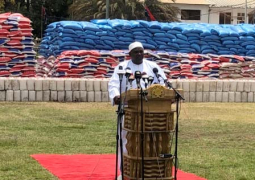
Delivering the study overview, project consultant and the Principal Investigator Omar Marena, said The Gambia faces growing climate-related threats such as sea-level rise, unpredictable rainfall, flooding, and rising temperatures. He noted that Banjul’s UHI effect where urban spaces become significantly hotter than surrounding rural areas has become a critical concern due to dense construction, declining vegetation, and inadequate planning.
Marena explained that monitoring conducted between 24 July and 26 August 2025 identified severe heat concentrations in several parts of the capital. Air temperatures exceeded 36°C in KG5, the Sewage area and Crab Island, while thermal imaging captured extreme surface temperatures ranging between 51°C and 57°C on concrete and asphalt in areas with little vegetation. Cooler zones such as McCarthy Square and the BCC headquarters recorded temperatures around 28°C, underscoring stark variations across the city.
He added that community surveys and focus group discussions involving 151 residents from Portuguese Town, Half Die, and Campama Ward revealed high exposure to heat, minimal shaded areas, and significant discomfort during peak temperatures. Public awareness of UHI and its health risks remains low, he said, reinforcing the need for continuous community education.
Marena outlined that the study used a comprehensive approach, including policy reviews, land-use and land-cover analysis, field monitoring, thermal imaging, and community engagement. Several national frameworks including the RF-NDP 2023–2027, the National Climate Change Policy, the National Land Policy, NDC2 commitments, and the Long-Term Climate Strategy 2050 were examined. While these policies support climate resilience, he said, they lack clear strategies for addressing UHI through urban planning, green space expansion, or revised building codes.
According to him, Banjul’s UHI challenge is fueled by multiple overlapping factors: dense construction, low vegetation cover, widespread impervious surfaces, limited shading, and poor drainage systems. He highlighted that the difference between air and land surface temperatures ranged between 4°C and 7°C, creating severe heat stress, especially for vulnerable groups. He stressed that addressing the crisis requires integrated solutions combining policy reforms, technical interventions, and community participation.
Speaking earlier, Aziz Dabakh Gaye, Deputy Mayor of Banjul, echoed concerns about The Gambia’s increasing climate risks rising sea levels, flooding, erratic rainfall, and prolonged heat waves. He said the UHI effect has become a serious urban climate challenge, intensifying temperatures in heavily built areas and contributing to health risks, increased electricity consumption, and reduced urban livability.
He referenced the recent UHI study, which confirms that hotspots like KG5 mini-stadium, Sewage, and Crab Island consistently recorded air temperatures above 36°C, while surface temperatures on asphalt and concrete rose to between 51°C and 57°C. Household surveys also revealed low awareness of UHI impacts, limited shaded areas, and rising energy demand for cooling across communities.
Gaye emphasised that tackling UHI must align with key national plans such as the RF-NDP, the National Land Policy, NDC2, the National Climate Change Policy, and the Long-Term Climate Strategy. These frameworks provide a solid foundation, he noted, but lack direct strategies for managing UHI.
The Deputy Mayor said the launch of the report is not merely ceremonial but a vital platform for dialogue, knowledge-sharing, and concrete commitments. He maintained that adopting scientifically grounded UHI mitigation measures will strengthen Banjul’s climate commitments, safeguard public health, reduce energy consumption, and position the city as a model for climate-smart urban development in The Gambia.





